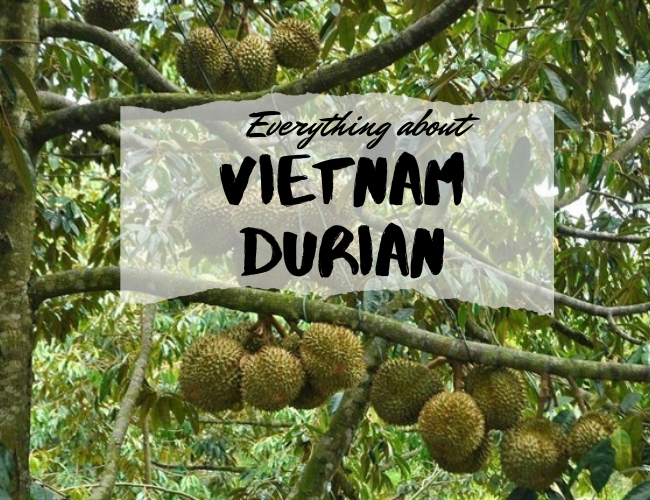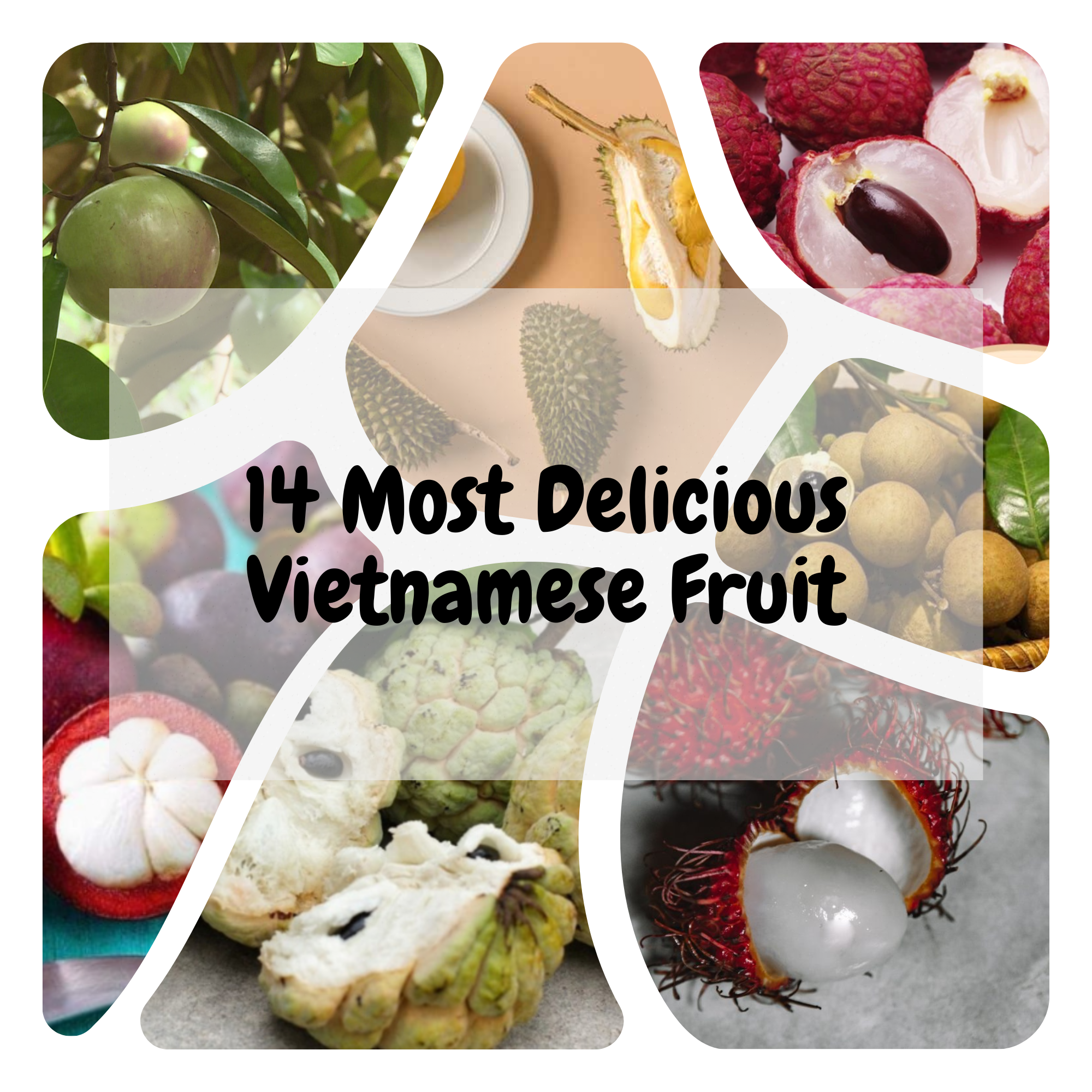Walking along some Vietnamese markets during the durian season, you can easily notice the unique odour of the Vietnam durian. Usually, in Vietnam, there are two opposite attitudes towards durians: loving them at the first bite or hating them immediately. Not only is this fruit grown and consumed in Vietnam, but also in many other Southeast Asian countries.
In this article, you’ll learn all about durians: their origin, their taste, where to buy them, and how to eat them.
About The Vietnam Durian: The Special Vietnamese Fruit
Durian (‘Sau Rieng’ in Vietnamese) is a member of the family Bombacacea, along with okra and hibiscus. Their season is from June to August, similar to some other tropical fruits such as the mangosteen, mango, and jackfruit. Durians are popular in Southeast Asian countries such as Vietnam, Malaysia, Thailand, and Singapore, where they are dubbed as the king of fruits for their large size.

With a thorn-covered rind, durians look fairly like jackfruits. They can be oblong or round or somewhere between, with husk green to brown colour, and their flesh pale yellow to red, depending on the species. The Vietnam durian can grow as large as 30 cm (12 inches) long and 15 cm (6 in) in diameter, and an average one weighs 1 to 3 kilograms (2 to 7 pounds).
Health Benefits Of Vietnam Durian
Durians are highly rich in nutrients. Every part of a durian tree, such as leaves, husk, roots, and fruit – has been used traditionally by the Malaysians to treat many diseases, including jaundice, high fever, and skin conditions.
Studies have shown that durian fruit can:
- Fight infection: In the rind, some compounds have antibacterial and anti-yeast properties.
- Reduce blood sugar: The Vietnam durian has a lower glycemic index (GI) than many other tropical fruits, meaning it is less likely to spike blood sugar levels.
- Prevent cardiovascular diseases: A number of compounds in durian may help lower cholesterol levels and your risk of atherosclerosis, or the hardening of your arteries.
- Lower cancer risk: The antioxidants in this Vietnamese fruit may neutralise cancer-promoting free radicals. In one test-tube study, durian extract blocked a strain of breast cancer cells spreading.
How Durian Smells And Tastes
The aroma of durians is so strong that you can smell it from far away. Just standing on the doorstep, you can recognize there’s a durian in the house, or just walking by the entrance of a market, you can know people are selling and buying durians in the fruit stalls. While many people regard it as an appealing fragrance, some others find it unpleasant, due to its composition of sulphur, esters, and ketones, which also compose “morning breath”. People have described the smell of this Vietnam durian variously as that of roadkill, rotting onions, sewage, and vomit or combinations thereof. After eating, the odour can linger in your hands for quite a long time.
Although the aroma is not so popularly loved, the taste of its flesh is praised by most eaters. Alfred R. Wallace, a 19th-century British naturalist, described its flesh as “a rich custard highly flavoured with almonds”. Many durian lovers say the Vietnam durian has a sweet, custardy taste, with the texture of creamy cheesecake. Flavours attributed to the durian fruits are usually caramel and vanilla. Different species have slightly to significantly different tastes. The taste varies according to the degree of ripeness as well.
The Usual Price Of Durians
The price of durian is rather higher than the average price of all fruits and it varies across countries. In Vietnam, durian prices range from 55,000-60,000 VND (~ $2.35-$2.50) per kg, depending on the quality and location in August 2022. The usual price of durians in Singapore is from S$18 to more than S$20 per kg.
Where And When To Buy Durians
As mentioned earlier, durians mature from June to August, so this is the time to buy durians. In Vietnam, durians are almost everywhere, from outdoor markets to supermarkets to fruit stores. In bigger cities like Hanoi, Ho Chi Minh City, or Da Nang, you can buy durians in the markets, supermarkets, or fruit stores. They are usually available in whole in the markets, and you can ask merchants to open them for you. Meanwhile, you can find that in supermarkets and fruit stores, the Vietnam durian is already opened and packed in transparent trays.

While buying durian flesh packed in trays is more convenient, selecting them in whole allows you to choose the good ones by judging the appearance. There are several ways to choose the perfect durian when buying. One is to hold it firmly with both hands and shake it. If the sound is hard and loud or hollow, the fruit is not ripe and the flesh is probably dry or the seeds are too big. If there is no sound, the fruit is likely overripe. The ripeness is ideal if you hear a little squishy sound, indicating the flesh is soft but not watery.
If you have a chance to visit Hanoi – the capital of Vietnam and want to try this special Vietnamese fruit, here are some of the popular durian stores for you:
1. Sau Rieng Co Hoa
Sau Rieng Co Hoa has been providing durians for Hanoians and visitors for 7 years. It offers a variety of durian species such as Ri6, Monthong, and Dona.
Address: 42M Ly Thuong Kiet St., Hoan Kiem, Hanoi
2. Donavi
Donavi is known as a wholesale and retail vendor of fresh agricultural products by Hanoians and people in neighbouring provinces. Durians provided by Donavi are mostly grown in the south and then delivered by air to Hanoi to ensure the shortest delivery time.
Address: 489 Hoang Quoc Viet St., Bac Tu Liem, Hanoi
3. Durian House
Located in downtown Hanoi, this durian store provides durians of several species, but mostly Ri6 and Monthong.
Address: 11 Thanh Nien St., Ba Dinh, Hanoi
4. Dai An Vegan
Dai An Vegan is a vendor of vegan products, fresh fruits, and greens. It is frequented by many durian lovers in Hanoi. Besides in-store shopping, Dai An Vegan also offers delivery services.
Address: 96 le Trong Tan St., Thanh Xuan, Hanoi
How To Eat Durians
If you buy a whole fresh durian, you need to cut it first and then eat it with your hands. It’s much easier if you buy it when the durian is cut into proportions. However, if you still want to buy the Vietnam durian in whole and cut it on your own, you’ll need some tutorials.
How To Open The Vietnam Durian
Opening durians in the wrong way can potentially ruin the whole fruit. Therefore, to open it properly, follow these steps:

#1: Make a cut in the top of the fruit with a sharp and large knife. The knife must go into 3-4 inches before you move it along the length of the skin.
#2: Use your hands to pull apart the skin and lay the two halves down.
#3: Use your hands or a spoon to take the flesh out and place them on a plate (or any container).
#4: Remove seeds from the flesh.
#5: Cut open the other sections and remove their flesh.
#6: Wash your hands after (under running warm water) to get rid of the smell.
And now, you can eat them! It’s not easy for one or two people to finish one durian at a time. So you should store them in the refrigerator for later use.
Durians In Different Sweet And Savoury Dishes
In many Southeast Asian cultures, people usually process durian as a special ingredient in sweet or savoury dishes. The Javanese cook durian into a sauce and serve it with rice or combine the pulp with onion, vinegar, and salt and use it as a relish. In some other regions, people smoke or ferment durians, while some dry them or make them into syrup. In Vietnam, durian-flavoured ice cream and candies are everywhere. Durian crepes, durian smoothies, and durian sweet soups are very common and widely-loved desserts in Vietnam.

The seeds of this Vietnamese fruit are edible as well. However, you must cook and process them before using them. They can be boiled, dried, fried or roasted. In Java, people slice them thinly and cook them with sugar or dried and fried with coconut oil and spices.
Note: Potentially Harmful If Combined With Alcohol
According to trusted sources, consuming durians at the same time as alcohol can spell trouble for your health. Scientists believe that sulphur-like compounds in this fruit possibly prevent certain enzymes from breaking down alcohol, which increases alcohol levels in your blood. This can lead to symptoms like vomiting, nausea, and heart palpitations.
The Bottom Line
Durian is a certainly interesting fruit: thorny on the outside, sweet on the inside. And the smell of it makes a lot of people disgust it right away, yet, attracts others immensely. Rich in flavour and nutrients, durians are one of the most expensive fruits in Southeast Asia. If you have a chance to visit this region, try durians and dishes made of them, whether it’s durian sticky rice in Thailand or durian sweet soups in Vietnam.
>> Read more: Top 7 Hanoi Cuisine: Delicious Food With Traditional Taste


